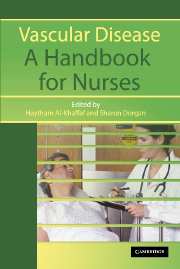2 - Vascular Emergencies
Published online by Cambridge University Press: 12 August 2009
Summary
RUPTURED ABDOMINAL AORTIC ANEURYSM
Rupture and leaking of abdominal aortic aneurysm is one of the most dangerous events in vascular surgery. Half of the patients never make their journey to hospital and die in the community. Of the other half, who arrive in hospital and are considered suitable for surgical repair, only 50% survive.
DEFINITION
Aortic aneurysm is permanent localised dilatation of 3 cm and above.
AETIOLOGY
The aneurysmal aortic wall is characterised by reduction of elastin and smooth muscle cells in aortic media layer with compensatory expansion of collagenous adventitial layer with atherosclerotic degeneration of the intimal layer of aorta. These changes result in weakness of aortic wall with the consequences of tear and rupture.
RISK FACTORS
Age >60 years.
Hypertension.
Sex: four times more common in males.
Diabetes.
Hereditary.
Smoking.
Hyperlipaedemia.
Ischaemic heart disease.
PRESENTATION IN ACCIDENT AND EMERGENCY
Leaking or rupture abdominal aortic or thoracic aneurysm is usually present with one of the following symptoms:
Sudden back pain.
Acute abdominal pain.
Collapse and shock.
Sudden, severe chest pain.
Acute lower limb ischaemia.
DIFFERENTIAL DIAGNOSIS
Myocardial infarction (MI).
Perforated ulcer.
Renal or ureteric colic.
Acute pancreatitis.
Acute cholecystitis.
Bowel obstruction.
- Type
- Chapter
- Information
- Vascular DiseaseA Handbook for Nurses, pp. 89 - 100Publisher: Cambridge University PressPrint publication year: 2005



